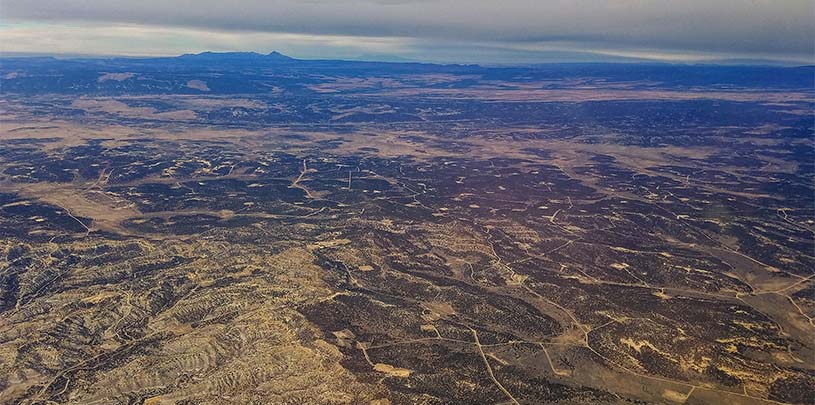
 by Megan Kelly, Energy Manager
by Megan Kelly, Energy Manager
Here on the Colorado Plateau, climate change is a huge problem, and we are already experiencing its impacts. The Southwest is facing rising temperatures in what is already one of the hottest and driest regions in the United States. We’re also facing increased water shortages and more intense and frequent wildfires. Look at Flagstaff, Arizona, where uncharacteristically heavy rains fell on top of a 2019 burn-scar, causing devastating flash floods last summer. Events like this and weather extremes will become more frequent as the climate continues to change.
At the Grand Canyon Trust, we’ve been working hard to better understand the main contributors to climate change on the plateau. Throughout 2019, the Trust worked with Lotus Engineering & Sustainability to measure greenhouse gas emissions across 41 counties on the Colorado Plateau. Here’s what we learned:
Greenhouse gases trap heat in the atmosphere and contribute to climate change. The main greenhouse gases we measured include carbon dioxide, methane, nitrous oxide, and others.
Carbon dioxide comes from many sources, including emissions from cars. Methane comes from livestock (yes, cow flatulence), mine shaft vents, and oil and gas wells (we have around 36,000 on the Colorado Plateau). Nitrous oxide emissions result from fertilizing in agriculture.
According to our greenhouse gas inventory, the top sources of emissions on the Colorado Plateau are electricity, transportation, and oil and gas production.
Because most electricity is being generated by fossil fuels, electricity use accounts for about a quarter of the plateau’s total emissions. Electricity powers everything from heating systems to TVs in homes, businesses, and industrial operations. Large utility companies provide the largest amount of electricity on the plateau and therefore are responsible for the highest proportion of emissions.
Coal-fired and natural gas power plants that produce electricity contribute significant emissions to the Colorado Plateau. Read more about it ›
Last year, more than 1.8 million vehicles entered Grand Canyon National Park and over 650,000 entered Arches National Park. So it is no surprise that transportation accounts for another quarter of the Colorado Plateau’s emissions. The majority of transportation emissions on the Colorado Plateau is from fuel burned in the types of vehicles you see on the highway — the cars, trucks, and buses we all use to travel, plus commercial freight. It also includes emissions from planes, off-road vehicles, farming equipment, trains, and boats used on Lake Powell.
Oil and gas wells emit a lot of methane and carbon, accounting for nearly a fifth of emissions on the Colorado Plateau. Northwest New Mexico and western Colorado are hotspots for oil and gas production.
Actively producing oil and gas wells account for most of these emissions. At these wells, methane often escapes from accidental leaks, or from an intentional release of gas, called venting. Sometimes oil companies will intentionally burn the gas instead of collect it — a process called flaring. Venting and flaring are sources of methane and carbon emissions.
Emissions also come from orphan wells, which are abandoned, unplugged oil or gas wells that no longer have an owner.
With an understanding of where greenhouse gas emissions are coming from on the Colorado Plateau, we can work to prevent worsening climate impacts. Electricity, transportation, and oil and gas production are the biggest contributors of emissions on the Colorado Plateau, and they offer the largest potential impact for emissions reductions.
From our work to reduce methane emissions at the federal level and shrink the methane cloud hovering above the Four Corners region, to engaging at a local level here in Flagstaff, the Trust is working to reduce emissions in our region. And using all of the data from our Colorado Plateau-wide greenhouse gas emissions inventory, we’re excited to ramp up our work in reducing greenhouse gas emissions to do our part in the global effort against climate change.
Did you know the Colorado River used to be called the Grand River? Learn about the name change and more fun facts about this hardworking river.
Read MoreChallenging conditions have endangered, threatened, or imperiled these five native fish in the Grand Canyon.
Read MoreBeneath the bathtub ring at Lake Powell, native plants are flourishing, cultural sites are resurfacing, and whitewater rapids are returning.
Read More